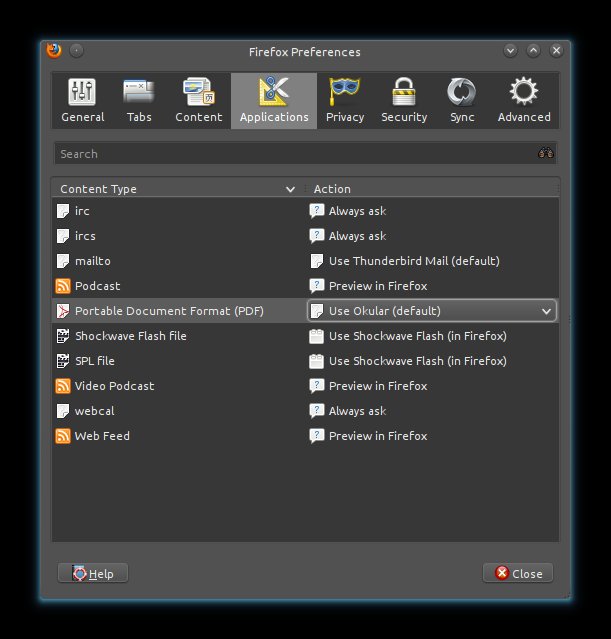The version of okular on my ubuntu 10.10 is 0.11.2, while the website shows the latest version to be 0.14
My question is - how do I get the latest version?
My update manager does not show any updates for okular although I dont know why.
If there is a .deb package for okular 0.14 that I can install please let me know. I wish to avoid compiling it from source myself.
Simple installer for Okular in Windows Systems After a few weeks of trial and error. During the installation, i can´t change the destination folder.
 fossfreedom
fossfreedom ♦
♦2 Answers
To have the latest version of Okular you have 3 options:
Easy Option - Install the latest Kubuntu. Either 11.10 or wait for 12.04. The reason for this will be explained in the other Options.
Intermediate Option - Download the DEB Package of Okular and all of it's dependencies and the dependencies of those dependencies until you have literally downloaded KDE in pieces just to install that since the latest Okular depends on libraries and other packages that also depend on others that need to be a specific version or newer. This versions are not compatible with an older Ubuntu so you would have to start downloading a lot of packages. This in most cases will not work and waste your time since at some point a package might say 'Hey I need a newer kernel version of autotool, autoconf, make... and so on.' So your chances of having it work there are very difficult.
Okular
Difficult Option - Compile the whole thing from scratch. This option will take more experience and a heck of more time to do and at the end it will not guarantee that it will work on the kernel used in Ubuntu 10.10 with the versions of the tools provided in 10.10.
To make matters worse, 10.10 has been discontinued. So try the option everyone has suggested (Install 12.04). If you do not want a heavy system then install Lubuntu or Xubuntu and then install Okular from there but just so you know, you can install Okular very easy and with less download time in Ubuntu 12.04 since it already comes with the QT libraries for it. No need to download them when trying to download Okular.
Luis AlvaradoLuis AlvaradoYou should try kubuntu 12.04 as it is pretty stable and has the latest release of okular. I have used it since beta1 and there has been no issues as crashes. Moreover the bug in the kernel which overheats the laptops is resolved in 3.2 series of the kernel.
Not the answer you're looking for? Browse other questions tagged 10.10okular or ask your own question.
For over a decade, KDE has supplied Linux and Unix users with a graphical desktop environment and a suite of useful applications. It has become one of the most popular desktop environments and is the default on many Linux distributions. With the coming of KDE 4, developers promised native KDE applications running on Windows. While the current release is still not ready for production, as of KDE 4.3.3, it is coming closer and worth trying. What follows is a brief guide to getting KDE running on Windows.
Download
The Windows download for KDE is not very obvious on the main KDE download page. It is not clear if this is deliberate, since it is still unstable, but the Windows installer for KDE is actually available on the KDE website. Download the .exe file and save it. Double-click it to run the installer, just as you would for any other Windows program.
Install
Okular Font
At this point you have only downloaded the small installation file and not the actual KDE packages. Therefore, select the first option in the installation window “Install from Internet”. The next screen will present you with several options about how to install KDE. Unless you are a developer or have some specific reason to choose the other options, just choose “End User”. This will install the binary packages for KDE, whereas the other options all require you to compile KDE from source.
On the next screen, you can choose which KDE programs to install. As you will see, there are quite a few KDE applications now available, although some are still missing. Select as many or as few as you like. Even if you realize that you want to install more software, the installer will let you install just those later on, without having to reinstall the previous ones.
Click next and follow the rest of the instructions just as you would with a normal installer. When it is complete, it will ask you if you want to run System Settings. Check the box and proceed.
Configure and Use
The System Settings program is currently functional, although many settings are not yet available to Windows users. Click on the “Advanced” tab and then click the “Platform” button. This is a unique non-Unix feature that allows you to select the level of Windows integration. Currently, Plasma is not available but apparently will be in the future.
Next, click on the “General” tab and click “Appearance“. Click the “Style” button and choose the widget style you prefer. KDE can integrate with the default Windows style or use the default KDE style: Oxygen.
Finally, run KDE applications just like you run regular Windows ones: directly from the Start Menu. KDE games work particularly well, as does the KDE text editor, Kate, which we covered two weeks ago. Always keep in mind that this software is not yet complete, but what they do have available works pretty well. For information and customization options, be sure to read the KDE TechBase documentation on Windows. KDE is free and open source software, which you can freely download, install, and redistribute.